通过蓝藻二氧化碳固定耦合沼气升级与生物聚合物积累
IF 8.4
2区 工程技术
Q1 CHEMISTRY, MULTIDISCIPLINARY
引用次数: 0
摘要
沼气主要由二氧化碳(CO2)和甲烷组成,需要通过去除二氧化碳来升级为生物甲烷,以提高其可用性,使其适合直接注入天然气网,并作为化石衍生甲烷的可再生替代品。本研究调查了最近分离的蓝藻菌株Synechocystis sp. B12的潜力,该菌株因其健壮性和对高光强的耐受性而被选中,用于沼气升级。聚囊藻(Synechocystis sp. B12)表现出对沼气中高浓度二氧化碳的特殊耐受性,利用它进行光合作用,而不会受到CH4或其他污染物的任何有害影响。这使它成为沼气升级应用的一个有前途的候选者。该菌株成功地固定了99% %以上的二氧化碳存在于合成气混合物和工业沼气中。此外,Synechocystis sp. B12将捕获的二氧化碳转化为聚羟基丁酸盐,这是一种可生物降解的生物塑料化合物,其生产率约为80 mg L−1。这种方法提供了提高沼气质量的双重优势,同时将二氧化碳转化为有价值的生物产品。本文章由计算机程序翻译,如有差异,请以英文原文为准。
Coupling biogas upgrading with biopolymers accumulation through cyanobacteria CO2 fixation
Biogas, primarily composed of carbon dioxide (CO2) and methane, requires upgrading to biomethane by removing the CO2 to improve its usability, making it suitable for direct injection into gas grid and serving as a renewable alternative to fossil-derived methane. This study investigates the potential of the recently isolated cyanobacterial strain Synechocystis sp. B12, selected for its robustness and tolerance to high light intensity, in biogas upgrading. Synechocystis sp. B12 demonstrated exceptional tolerance to high CO2 concentrations as in the biogas, utilising it for photosynthetic growth without any detrimental effects from CH4 or other contaminants. This establishes it as a promising candidate for biogas upgrading applications. The strain successfully fixed over 99 % of the CO2 present both in synthetic gas mixture and industrial biogas. Moreover, Synechocystis sp. B12 converted the captured CO2 into polyhydroxybutyrate, a biodegradable bioplastic compound, achieving productivities of approximately 80 mg L−1. This approach provides the dual advantage of enhancing biogas quality while simultaneously transforming CO2 into valuable bioproducts.
求助全文
通过发布文献求助,成功后即可免费获取论文全文。
去求助
来源期刊

Journal of CO2 Utilization
CHEMISTRY, MULTIDISCIPLINARY-ENGINEERING, CHEMICAL
CiteScore
13.90
自引率
10.40%
发文量
406
审稿时长
2.8 months
期刊介绍:
The Journal of CO2 Utilization offers a single, multi-disciplinary, scholarly platform for the exchange of novel research in the field of CO2 re-use for scientists and engineers in chemicals, fuels and materials.
The emphasis is on the dissemination of leading-edge research from basic science to the development of new processes, technologies and applications.
The Journal of CO2 Utilization publishes original peer-reviewed research papers, reviews, and short communications, including experimental and theoretical work, and analytical models and simulations.
 求助内容:
求助内容: 应助结果提醒方式:
应助结果提醒方式:


